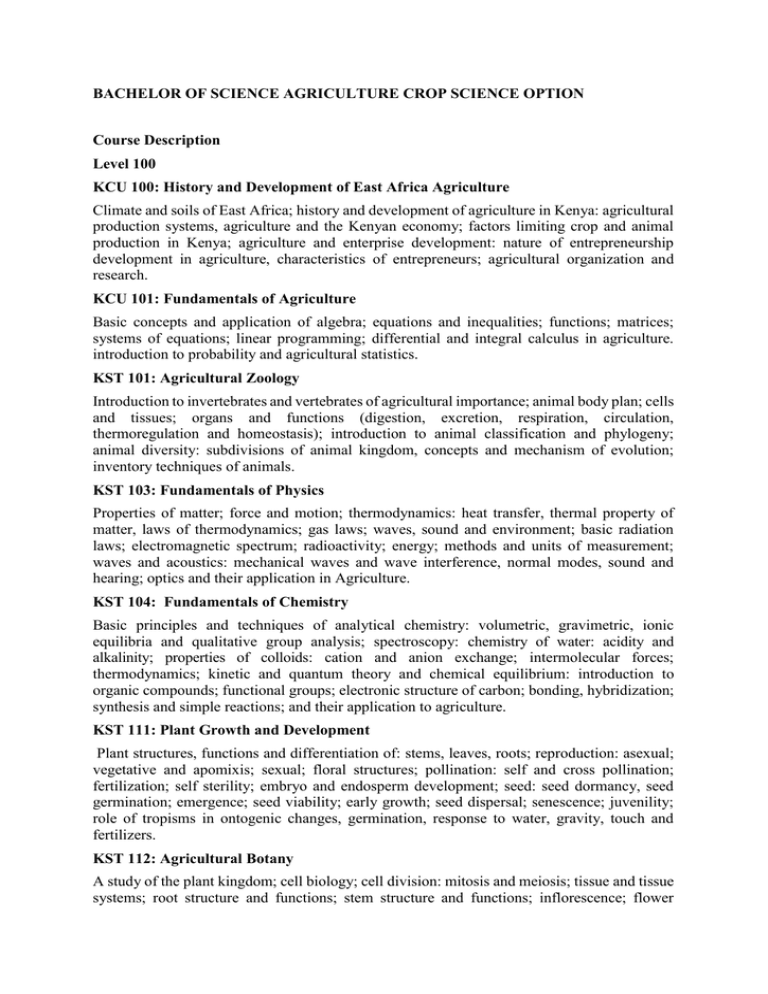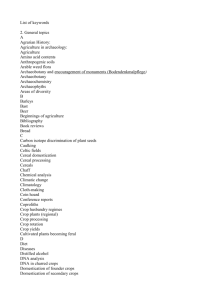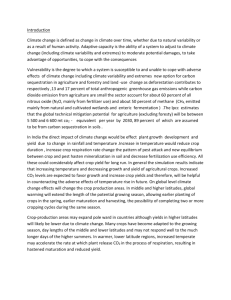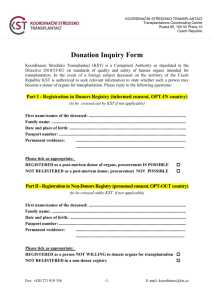BSc_AGRICULTURE_CROP_SCIENCE_OPTION
advertisement

BACHELOR OF SCIENCE AGRICULTURE CROP SCIENCE OPTION Course Description Level 100 KCU 100: History and Development of East Africa Agriculture Climate and soils of East Africa; history and development of agriculture in Kenya: agricultural production systems, agriculture and the Kenyan economy; factors limiting crop and animal production in Kenya; agriculture and enterprise development: nature of entrepreneurship development in agriculture, characteristics of entrepreneurs; agricultural organization and research. KCU 101: Fundamentals of Agriculture Basic concepts and application of algebra; equations and inequalities; functions; matrices; systems of equations; linear programming; differential and integral calculus in agriculture. introduction to probability and agricultural statistics. KST 101: Agricultural Zoology Introduction to invertebrates and vertebrates of agricultural importance; animal body plan; cells and tissues; organs and functions (digestion, excretion, respiration, circulation, thermoregulation and homeostasis); introduction to animal classification and phylogeny; animal diversity: subdivisions of animal kingdom, concepts and mechanism of evolution; inventory techniques of animals. KST 103: Fundamentals of Physics Properties of matter; force and motion; thermodynamics: heat transfer, thermal property of matter, laws of thermodynamics; gas laws; waves, sound and environment; basic radiation laws; electromagnetic spectrum; radioactivity; energy; methods and units of measurement; waves and acoustics: mechanical waves and wave interference, normal modes, sound and hearing; optics and their application in Agriculture. KST 104: Fundamentals of Chemistry Basic principles and techniques of analytical chemistry: volumetric, gravimetric, ionic equilibria and qualitative group analysis; spectroscopy: chemistry of water: acidity and alkalinity; properties of colloids: cation and anion exchange; intermolecular forces; thermodynamics; kinetic and quantum theory and chemical equilibrium: introduction to organic compounds; functional groups; electronic structure of carbon; bonding, hybridization; synthesis and simple reactions; and their application to agriculture. KST 111: Plant Growth and Development Plant structures, functions and differentiation of: stems, leaves, roots; reproduction: asexual; vegetative and apomixis; sexual; floral structures; pollination: self and cross pollination; fertilization; self sterility; embryo and endosperm development; seed: seed dormancy, seed germination; emergence; seed viability; early growth; seed dispersal; senescence; juvenility; role of tropisms in ontogenic changes, germination, response to water, gravity, touch and fertilizers. KST 112: Agricultural Botany A study of the plant kingdom; cell biology; cell division: mitosis and meiosis; tissue and tissue systems; root structure and functions; stem structure and functions; inflorescence; flower pollination and fertilization; seed; fruit; principles and systems of classification; characteristics of agricultural important families: Malvaceae, Brassicaseae, leguminosae, compositae, solanaceae, cucurbitaceae, convolvulaceae, gramminae, liliaceae and musasea. KST 130: Field Course 1 Visit mid and high altitude agroecological zones in Western region; land fragmentation; farming systems; soils, degradation, conservation; vegetation types; large scale; tea, coffee, rice; Horticulture: flowers, vegetables, fruits. Small scale: maize, beans, yam, banana, cotton; livestock management: zero grazing, fish farming; water harvesting; Irrigation; crop-soilclimate relationships; agriculture versus poverty alleviation; The course will take a minimum of five (5) days. KBT 100: Principles of Agribusiness Economics Interactions between business firms and society; aims of business vis a vis those of society; forms of business ownership: sole-proprietorship, partnership, companies, government corporations and cooperatives; sources of business finance; stock exchange markets; social responsibilities of business; characteristics of foreign companies operating in Kenya; major management functions: planning, organizing, directing, controlling and staffing; delegation of authority and responsibility, marketing, personnel and production. KAP 100: Introduction to Animal Science Definitions of animal production, husbandry, management and veterinary science; animal science disciplines; the role of animal production in agriculture and national economy; crop versus animal production; the role of animal production in human nutrition; animal products and national requirements; a survey of animal production systems. KAP 103: Physiology and Anatomy of Farm Animals Gross anatomy of farm animals; systemic description of various organs; morphology of organs systems and topographical studies using complete farm animals for dissection of preserved specimens of body systems; digestive, circulatory, musculoskeletal, reproductive, thermoregulation, and peripheral nervous system; embryology with emphasis on derivation of organ system; physiology of farm animals and their interrelationships to give the basis knowledge needed to understand normal and abnormal states of body. LEVEL 200 KCU 200: Statistics for Agriculture Definition and importance of statistics; population; sample; methods of data collection and presentation; concept and types of variability, parameters and estimates, frequency distributions, measures of central tendency and dispersion; probability: some probability distributions, estimation and testing of probability; simple linear regression and correlations; normal distributions; concept of hypothesis testing separation of means, Z, F and t-tests; studying linear relationships simple linear regression and correlation; computer assisted data analysis. KCU 201: Principles of Crop Production Economic importance of crops in Kenya; crop environment and effects on yields, crop propagation methods, crop husbandry, land preparation; examples of annual and perennial crops; cropping systems: monoculture, crop rotation, polyculture etc; importance of crop calendar; fertilizers, manures and plant nutrition; crop-water relations; weeds, crop pests and their control; crop storage; KCU 202: Principles of Soil Science Introduction to soil science, soil forming factors and processes; soil components; minerals and organic matter; forms of soil aggregate; peds and pores; chemical reactions on the soil colloidal surfaces; soil aeration; drying and wetting of soil; soil physical properties; water holding capacity, bulk density electrical conductivity and texture; soil chemical properties: pH, cation exchange capacity; bases and soil oxides; plant nutrients; soil organisms. KAP 203: Animal Nutrition Nutrition concept; metabolism and utilization of nutrients: carbohydrates, proteins, lipids, vitamins, minerals and water; analysis of feed quality proximate analysis; fiber determination; in vitro and in vivo digestibility; dry matter degradability; energy systems used in nutrition: physiological fuel values, gross, digestible, metabolizable and net energy; total digestible nutrients, starch equivalent; evaluation of protein quality and nitrogen balance index; fasting catabolism, metabolic body weight and basal metabolism. KST 204: Agricultural Microbiology Prokaryotic and eukaryotic cells: reproduction, nutrition, biosynthesis; cell morphology; introduction to microbial diversity and taxonomy: viruses, bacteria, fungi; economic importance of micro-organisms: agriculture, environment, food, health; nitrogen and carbon cycles; handling micro-organisms: culture media, sterilization, isolation, staining and microscopy techniques; Growth measurement: bacteria and fungal counts; preservation methods; chemical and molecular characterization of micro-organisms. KST 206: Principles of Agricultural Biotechnology Biotechnology in agriculture and food production; doubled haploids; embryo culture; In vitro selection; creation of variability (induced variation, somaclonal, protoclonal, gametoclonal variation); Protoplast culture and fusion; micropropagation,; cryopreservation; somatic embryogenesis; organogenesis; secondary metabolites; Mutagenesis: Physical and chemical mutagens, point mutation, gross mutations; DNA, proteins and central dogma of biology; DNA sequencing and diagnostics; genetic engineering: vectors; Genetically modified organisms (GMOs), regulation, biosafety, legal and ethical issues of GMOs; DNA Molecular markers and applications. KST 208: Insect Biology and Ecology Economic importance of insects; insect dominance and success; insect abundance; categories of insects: exopterygota; endopterygota; insect biology, morphology and function; modifications; relationships to man and plants; Ecology; population; natality; mortality; fecundity: species diversity, species richness, insect community; social insects; abiotic and biotic factors for insects abundance, growth, outbreak, predator-prey and host-parasite interactions, intra and interspecific competition; mimicry; commensalism. KST 209: Principles of Crop Improvement Introduction to botanical nomenclature, scientific vs. colloquial names; international code; introduction to botanical terminology; vegetative organs; reproductive organs; fruits; vegetative morphology; studies on family characters of field crops; survey of the plant kingdom; taxonomy and ecology of plant families; domesticating of plants; influence of plants and plant products on human history and civilization. Basic principles and methods used for genetic improvement and seed production of agronomic crops; cultivar and systems selection, diagnosis and adjustment of nutritional status; use of physical, chemical and cultural aids; clone; propagation; stems, roots, stems, pruning; management of cultivars; harvesting; handling; marketing operations. KST 214: Plant Physiology and Biochemistry Introduction; Osmotic regulations; Ascent of Sap; Transpiration; mechanism and relevance; Translocation: path, source, sink and strengths; Photosynthesis: pigments; light and carbon reduction reactions, photosystems; carboxylation pathways; Noncyclic and cyclic photophosphorylation; Biosynthesis and degradation: carbohydrates, Lipid (including interconversions), Vitamins; characteristics, nomenclature and classification; Amino acids and proteins; essential and nonessential amino acids, protein structures; Respiration; respiratory mechanisms and substrates; ETS, Enzymes and coenzymes; Photorespiration and plant adaptations; Plant growth substances: identification, structure and synthesis. KST 230: Field Course 2 Visit mid and low altitude agro-ecological zones; land fragmentation; farming systems; soils types, zonation, use, degradation, conservation; Dry land farming: cowpea, sorghum, green grams, fruits, cassava; livestock management: ranching, rangelands, fish farming; vegetation types, grassland, open savanna, forests; wildlife management; large scale farms; sisal, coconut. Water management: harvesting, use, conservation; agroforestry; marine environment and resources, mangrove swamps. The course will take a minimum of five (5) days. KRM 201: Agricultural Machinery Land suitability for agriculture; types of land development and preparations, timing of cultivation, seedbed establishment; seeding, planting, weeding. Farm operations and performance; machinery and farm tools; land survey and design of foundations; suitable farm structures for different types of uses, engineering drawings and farm structures, tillage and soil consistency, overview of machines and mechanized systems for agricultural production. KBT 202: Agricultural Production Economics The production function and management process; production models; basic concepts of microeconomics; entrepreneurs’ choice of what to produce; the pricing mechanism; determination of output level in the various market structures; National income and expenditures according to neoclassical and Keynesian theories; inflation, economic growth; money supply; applications in agricultural enterprises. SBC 120: Introduction to Genetics KAP 203: Animal Nutrition LEVEL 300 KCU 300: Field Attachment Exposure of students to actual issues, problems and opportunities in agricultural science and technology; students will have the opportunity to utilize their knowledge, skills and techniques in real situations under the guidance of those practicing; the internship/outreach will normally last for a duration of three months. KST 300: Principles of Seed Science and Technology Seed physiology: seed development, seed maturation, seed germination, dormancy and deterioration; Functional concept of seed: chemical composition of seed, physical properties and their significance; Principles and practices of seed production: seed harvesting, drying, storage, treatment and packaging; Seed distribution and marketing; seed testing and quality control; plant breeders’ rights; laws and regulations in the seed industry. KST 301: Agricultural Entomology Population biology of insect pests; insect morphology; reproduction; life cycles; taxonomy of insects; principles of insect pest management; pest control practices: chemical, cultural, biological, predators, parasitoids, microbial; host plant resistance; integrated insect pest management (IPM); bionomics of insect pests; examples of pests of agricultural importance. KST 302: Crop Diseases and Management History of plant pathology and economic importance; biotic and abiotic plant disease causing agents; predisposition of plants to diseases; plant response to infection; diseases of post-harvest products: fruits, flowers, vegetables, cereals and pulses; perennial crops; major symptoms of infected crops; Crop loss assessment; disease control and management methods. KST 304: Weed Science and Management Definitions; effect of weeds on production, management and quality of agricultural crops; origin and botany of major agricultural weeds in tropics; dissemination; survival of weeds under various environmental conditions; competition between weeds (both free-living and parasitic) and crops; weeds as alternative hosts to crop pests and diseases; weed control methods in agricultural crops. KST 307: Crop Production in Controlled Environment Greenhouse structures and function; design; construction; heating; ventilation; cooling; environmental control; growing media; pest management; sterilization; plant nutrition; hydroponics; growth regulation; irrigation systems; post-harvest handling; physical screens; pest control; protected crop propagation facilities: tissue culture, grafting, in-vitro screening; GMO research facilities; quarantine areas and facilities; policies and regulation; Production technologies for fruit, vegetables and protected crops. KST 309: Pesticide Formulation, Use and Safety Categories and classification of pesticides: insecticides, nematicides, organophosphates, carbamates, organochlorides, bio-pesticides; pesticide formulation; mode of action; classification by activity; systemic and contact pesticides; soil-applied; pre-plant incorporated; preemergent post-emergent herbicides; pesticide efficacy; application methods; safe and effective use of pesticides; legislation; legal use of pesticides; maximum residue limits (MRLs); phyto-toxicity; crop selectivity; resistant plants; bioassay of pesticides. KCU 301: Agricultural Research Methods Role and objectives of research in agriculture; Problem identification; Situational analysis; Project proposal: objectives, literature review, research area/ materials, methodologies, expected results, discussion; Project work: design and layout of experiments in agriculture, data collection techniques, evaluation of results, information presentation methods; Research organisation: planning, budgeting, and costing of research projects; Principles of experimental designs and analysis; completely randomized design, randomized complete block design. KST 313: Principles of Organic Farming Introduction: problems of conventional agriculture production; principles of sustainable agriculture; overview of organic agriculture; soil as a basis of organic plant production; integration of agriculture and nature; pest and disease management in organic agriculture; organic seed production and plant breeding; organic food chains; economics of organic plants; food safety; international regulations on organic plant and livestock production; Global-GAP; niche market, international trade on organic food production and products. Prospects, challenges and constraints. KST 318- Value Addition in Crop Products Definitions of Value Addition and Crop Products; Types of crop products from Horticultural, Food, Fodder and Industrial crops; Value Addition in Food Crop Products; Technology for value addition of crop products; Challenges in value addition; Value addition at different stages; Sustainability of value added products and technologies; Strengths, Weaknesses and Opportunities; legal, ethical issues’’. KRM 300: Soil Fertility and Plant Nutrition Definition of soil fertility; essential plant nutrients and their availability in soil; essential elements and their influence on plant growth; non-essential elements and elements toxic to plant, nutrient uptake by plant; physiological functions of essential elements in plants, their deficiency symptoms and toxicity; soil organic mater and importance of humus in soil, microbiological transformation in the soil and nutrients cycling. Methods of manure and inorganic fertilizers and their fate in soil, crop response and fertilizer use recommendations. KBT 300: Applied Agribusiness Concepts of management; role of marketing, marketing management in farm business; ideal farm layout and applications; inventory taking and valuation techniques of farm assets; elementary farm accounting, net income net worth statements; planning and budgeting techniques: partial budget, capital budgeting, total farm budget, cash flow budget, price and yield information; farm management techniques EMS 438: Agro-Meteorology LEVEL 400 KCU 400: Research Project (equivalent to 2 units) Introduction to integrated agriculture for research; undertaking of a research project; The choice of topic will be made after a visit and interaction with a farming community or an agricultural enterprise and in consultation with assigned supervisors in the Department; developing and presenting research proposals, collecting, analysing data, writing and submitting final project reports in journal paper format; Making oral and or poster presentations in the Department. KST 401: Post Harvest Technology Importance in food security; Pre-and postharvest physiology and biochemistry; maturation, ripening and senescence; role of hormones in shelf life of fruits; pre-harvest factors affecting quality and shelf life; sites of losses and loss management techniques; harvesting techniques; post-harvest handling: pre-cooling, packaging and storage techniques for fruit, vegetables, grains, medicinal and plantation crops. Physiological disorder, prevention and management; specific post-harvest treatments for locally important crops; traditional methods of post-harvest technology. KST 407: Integrated Pest and Disease Management Strategies Principles of Integrated Pest Management (IPM) and the applications of these principles for insect pest and disease management; surveys of pests, diseases and weeds, alternative practices and non-chemical means of control, monitoring and forecasting methods, and strategies for management and their implementation; examples of existing IPM programs in practice; emphasis on the integration of different methods for maintaining pests, diseases and weeds below damaging levels, with the goal of minimizing the use of chemical pesticides that disrupt the environment. KST 408: Agriculture Extension and Rural Development Meaning of rural development and rural poverty; gender and poverty; development theories and strategies in rural development; nature and scope of agricultural development; role of agriculture in socio economic development; theories of agricultural development; approaches and strategies to rural development, e.g. millennium development goals (MDGs), decentralization, community development, integrated rural development, gender approaches to development etc. rural project planning, identification, design, monitoring and evaluation. KST 413: Agricultural Policy and Law in Kenya Agricultural laws of Kenya and the National Agricultural policy; functions of government and other stakeholders in agricultural policy setting and implementation; role and functions of agricultural boards and other organs; legal impediments to agricultural development; relationship with Environmental and Coordination Act (EMCA); formulation, planning and execution of agricultural programmes; implementation and evaluation; legal considerations in the design and implementation of multi-purpose projects. KST 414: Pastures and Fodder Crops Production Identification of pasture grasses; legumes and fodder crops; ecology and distribution of natural grasslands in Kenya; pasture and fodder crop agronomy; conservation and utilization; pasture and fodder crop improvement; natural grasslands; sown pastures, relative productivity, efficiency of resource use; structure and physiology of forage plants: grass and legume anatomy, morphology and photosynthesis; nutrient uptake, species and varieties of pastures plant; grass and legume selection and breeding; seed production; pasture establishment; fodder crops for domestic animals; agroforestry practices in cropland; alley cropping, on-farm live fencing multipurpose trees. KST 416: Field and Industrial Crops Production World distribution; economic importance; utilisation of industrial crops; requirements; genetic improvement; propagation; cultural practices; pests and diseases and their control; harvesting; post harvest handling; processing; storage; marketing of industrial crops: coffee, tea, sugarcane, cashew, coconut, macadamia, pyrethrum, sisal, cotton and tobacco. KST 420: Pests and Pathogens of Stored Products Economic importance of pests of stored products; recognition of stored grain pests: legumes, pulses, grains; factors influencing abundance and distribution: behaviour, adaptability, life cycle, reproduction; mode of attack; outbreak and damage; assessment of damage; principles of insect pest control; control methods; regulation and enacted laws for inspection and prevention of spread of insect pests in imported and exported products; fungal pathogens; mycotoxins. KST 421: Horticultural Crops Production World distribution; economic importance; ecological requirements; genetic improvement; propagation; cultural practices; pests and diseases; control methods: chemical, biological, cultural, mechanical; harvesting; post harvest handling; processing; packaging; storage; marketing of industrial crops; fruit production; vegetable production; medicinal production; herbs and spices. KST 422: Agroforestry Systems History of agroforestry; definition and concepts; agroforestry attributes; classification of agroforestry; agroforestry systems, technologies and practices; general principles of plant (trees and herbaceous plants) productivity; climate change and carbon credit; effects of trees on soils; nutrient recycling and organic matter; micro-flora and macro-fauna in agroforestry systems (n-fixation, mycorrhizae and actinomycetes); agroforestry and soil conservation; design of agroforestry systems; policy issues in agroforestry. KBT 414: Agribusiness Entrepreneurship and Management Philosophy, Nature and Meaning of entrepreneurs, Achievement desire, goals setting Drive, energy, self-confidence, risk taking. Starting and establishment of small agribusiness enterprises. Evaluation of on-going small business enterprises. Proposal writing for raising agribusiness capital. Buying an ongoing small agribusiness enterprise. Customer relations. Small agribusiness development and expansion. KRM 406: Soil and Water Conservation Measurement of distances and areas; Chain and compass surveying; Levelling and topographic surveying; Hydrologic cycle; Rainfall - runoff processes; Measurement of rainfall and runoff; hydrograph; Mechanics of water erosion; Field structures and practices to control erosion by water; Gully control; Wind erosion and control; Soil conservation structures; Water harvesting and conservation. KRM 403: Irrigation and Drainage Factors that condition irrigation, drainage, irrigation history and status in Kenya, irrigation methods and suitability for crop production, surface, sub-surface, overhead trickle/drip irrigation; evapo-transpiration and crop water requirement, soil and plant factors affecting evaporation, consumptive use; the Blaney-criddle method, penman’s method and lysimeter method; evaluation of water available in plant, classification of soil water, quality, scheduling of irrigation, measurement of infiltration rate, saline and alkali soils, management of saline and alkali soils, leaching requirements; drainage, drainage functions, requirements and field designs.



